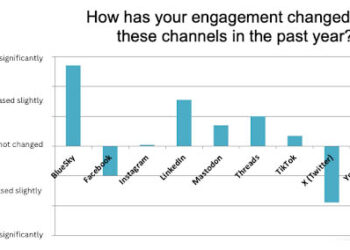
- Image by DavidDMuir via Flickr
The notion that information wants to be free is absurd when the delivery mechanism is making a fortune and the creators are getting what amounts to zilch. – Peter Osnos, “Will Google Save the News?“
In order to focus their attention on big institutional content deals, publishers have traditionally relied on third-party service providers (agents and the like) to conduct business with individual end-users. However, with institutional budgets in decline, content providers are turning their attention to consumer markets as a potential source of business growth. Asserting themselves in the consumer space will require a new type of sales and marketing acumen and visibility into consumer behavior, which recognizes and responds to the many new ways that consumers are seeking to interact with vendors and each other in online environments.
The longstanding business equation in B2B publishing has been:
Quality Content + Brand Recognition + Operational Efficiency + Institutional Usage = Market Share/Financial Success
Publishers have negotiated big deals, but have largely let consumers fend for themselves. This strategy will not fly in consumer markets, where visibility and demand are the primary drivers of revenue, and where methods for marketing to consumers have changed dramatically. The best approach for publishers wishing to enter the consumer marketplace is to take a step back, free themselves from preconceptions of what their business is about, and take a look at what is really working in the consumer Web. Only through entrepreneurial thinking will they have a shot at success in consumer content markets.
Where the Money Is and Content Should Be
Consumers tend to be more willing to spend for services that meet an interest or demand than for non-interactive content, which, according to a survey from Viximo represented only 18% of 2009 virtual commerce spending. Even media darlings like the Huffington Post have extremely modest per capita revenues because they have failed to break out of the advertising-supported model for delivering flat content. According to a recent article in Newsweek, HuffPo will generate $30 million in advertising this year from its nearly ~24 million unique monthly visitors and is only recently profitable.
By contrast, from an article in this week’s Washington Post:
More than 200 million people play social games every month. . . . The business opportunity is enormous, even though playing the games is free. Users can buy add-ons and move through game levels faster by spending a dollar here, 50 cents there on what amount to nothing more than virtual objects on a screen. Analysts predict more than $835 million in such transactions this year. . . . The games can be played across platforms — if you’re away from your computer and your wheat needs to be harvested, you can do the work on your iPhone. A simple text message tells you when it’s time.
Are publishers in denial that consumers want and will pay for better, more targeted, and more relevant services? Is this simply an unaccustomed way of thinking about customer needs at an individual level?
The new status quo is that consumers are constantly inundated with free content but are rapidly flocking to demand-based, interactive services and are making freemium purchases in that context. Content providers can meet this reality head-on by wrapping content in value-added service layers that address consumer needs and support collaboration (sounds simple). Then, the remaining challenge to anticipate and overcome is the transaction.
What It Takes for Consumers to Pay
Consumers will pay for content services only if demand-based purchasing can be made convenient and seamless enough. In Asia, micro-commerce and phone payments have been broadly implemented. Companies like Facebook, Google, Zong, TwitPay, and Flattr are making progress in this direction, and the U.S. consumer market is ripe for a ubiquitous, demand-driven micro-purchasing system (or iTunes model) that spans devices, platforms, products, and services.
Currently, this only exists in the online gaming space.
According to Flattr, whose system for monetizing online content across websites is explained in this YouTube video:
Micropayments are the Holy Grail of online exchange. Being able to pay for the content you like, even if it’s a small sum, makes a huge difference.
For further encouragement that micropayments can amount to something substantial, one can look to Zynga, which raised more than $1.5-million for relief to Haiti in January from players of their Farmville game.
Provided that micropayment capabilities continue to develop, there will be new opportunities for publishers and others to monetize content-related services online versus simply delivering flat content. This may sound like a minor distinction. In fact, there will be far-reaching business implications that require a strategic and operational re-orientation.
Despite these challenges, there is a real need for publishers to think outside their traditional roles and participate in developments in the e-commerce and virtual services sectors.
Publishers pursuing a growth curve may discover that good things come in virtual packages. Those who can’t make the conceptual leap may find themselves in the back seat of a car moving at Web-speed with consumer service companies at the wheel.
Discussion
11 Thoughts on "Leading Your Content to the Money — A New Equation for Selling Content to Consumers"
Micropayment is certainly an angle worth exploring. The big question for scholarly presses is what microservices readers are willing to micropay for? Readerships can be pretty small. This is not a matter of being old fashioned, but rather of not having a clue what might work, plus a considerable up front experimental development cost. Plus the risk of an adverse customer reaction.
Who wants to be first? Or is somebody trying this already?
It’s easiest to justify when the site functionality serve a practical/business purpose, even for individual users. When we designed First Street at CQ Press, we conceived of it as having a non firewalled access layer for free exploration. Deeper access to content and services could be achieved via licensed IP access or micro ecommerce payments by individuals. The biggest obstacle, as I see it, is the lack of a ubiquitous ewallet/need to set up a personal account. I will pay 99 cents via mobile one-touch on impulse. Much more if the service helps me get my job done.
The similarities between online games and online scientific content may be a little stretched here. For the latter, we have an institution that has historically placed itself as the purchaser of content for its readers — the academic library. The online gaming marketplace has no third-party purchaser and markets all of its products directly to the consumer.
Many years ago, journals like Science attempted to provide individual member services (like ScienceExpress, a service for being alerted to selected e-papers before print), only to end up selling this service to institutional libraries. Providing advanced content to some readers but not others just didn’t seem fair. In 2001, a Nature institutional site-license agreement to delay access by 3 months also did not fair well in the academic library world.
In general, libraries don’t like providing second-rate information services and scientists don’t understand why they would need to pay extra when their libraries are already subscribers. Creating small costs to readers (micro-payments) are not really the solution here because they don’t adequately address the perception problem of who should pay for information services on campus.
The real challenge for publishers, as I see it, is creating information services that are not perceived as being part of content, but something else. This is a framing problem, not a payment problem.
To clarify, this post discusses consumer market sales as additive to institutional sales for publishers seeking growth in a flagging institutional sales market. Consumer sales in this context are not conceived of as supplanting the institutional sales base. I’m not sure where the lesser quality argument comes in.
I think the problem for most academic publishers (at least for us) is that the consumer market has very little interest in our content, and is unlikely to have the training necessary to read and fully understand our content.
It’s perhaps off-topic, but if academic publishers want to consider micropayment systems, then Phil has a good point about the differences in the way purchasing is done in the two markets (and perhaps this responds to David W’s comment above): the researchers who read our publications generally don’t pay for them out of their own pockets. Journals are purchased through their libraries, books are purchased on grants. Any micropayment system that’s going to work would have to be set up to integrate with the various payment systems in place at universities for spending grant money. And since these vary so much, that becomes technologically difficult. Once you start adding in layers like this, the purchasing process becomes bogged down, you can’t make a quick impulse buy if you’ve got to get your librarian’s permission first.
I agree. The question is, then, what aspects of science are interesting enough to end users making impulse purchases. Web MD demonstrates that there is public interest in current health science information. Another challenge is to develop tools that make the content more useful, relevant, and compelling outside the journal context.
For example, data mapping tools that point to rich but unexplored research topics would have value to lay people, researchers, and entrepreneurs. Then, take this data and overlay with financial data. This becomes a VC idea mining tool and innovation starter.
Responding to David Crotty, in library purchasing environments, I’d point to patron driven acquistion platforms (such as EBL’s Demand Driven Acquisition and many others gaining popularity). These work like Flattr for libraries and are scalable. The library sets up a deposit account with fund codes and auto and manual approval settings, which allow patrons access to a broad swath of content for trial and purchasing or rental following the trial period. This has been in use in libraries since 2004 and gets good reviews from librarians, patrons, and publshers.
Back to why consumers might care about content-driven science services …
There is a large precedent in the sale of individual journal articles to non subscribers. Medical information probably has the broadest need, and is highly episodic, although anything with applied implications might work.
But selling articles is a brute force solution compared to the value added services you are talking about, Alix. There is indeed an emerging array of analytical and science visualization capabilities that might support a consumer market. I myself am exploring this issue. There is no intrinsic reason keeping a publisher from having a “consumer portal” with a menu of subscribable or purchasable mini-features. But I think the pony is still to be found.
Agree with you, David. Interestingly, Web MD has spun out from content to product sales and is now in the medical device business. It seems to me that “finding the pony” may be an evolutionary process that begins with focusing on individual interests and needs. Discerning how science can help consumers is a great start. Environmental and energy science would be a great one to explore.
Excellent post, Alix. I think the mis-understanding is on the term ‘consumer’. I don’t believe a typical teenager is going to read a journal on genomics. Rather I think of this potential audience as ‘non-institutional users’, those individuals and small/med biz users who do not have subscription access. They typically arrive via Google and often comprise a majority of the traffic to a pub site. And in contrast to the belief that even these users are not “sophisticated” enough, we’ve seen with one STM publisher that these users attempt to go from Abstract to Full-text over 79% of the time – clearly, a person wouldn’t try to read the full-text if they weren’t trained to read it.
I agree that it’s important that publishers experiment with variable access models. Obviously gaming isn’t the literal analogy, but these gaming companies have developed expertise in testing and successfully selling alternative access models – start for free, then pay a little bit more money for a little bit more stuff. Publishers on the other hand have been selling 2 “things” for the past 300 years: print and PDF. Everyone gets one or the other regardless of their needs and budgets. That was relatively easy when the ‘customer’ was largely homogeneous. Today, there is a global, growing audience of new users who want this information and are actively looking for it, but have variable abilities to purchase it. To Alix’s point, I believe publishers should experiment with how to meet those unmet needs.



